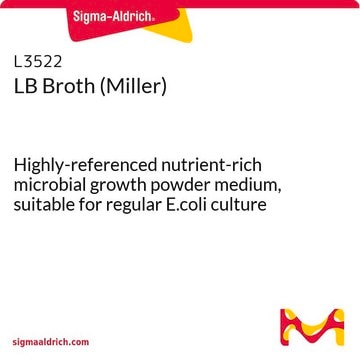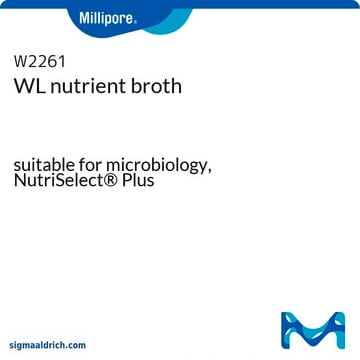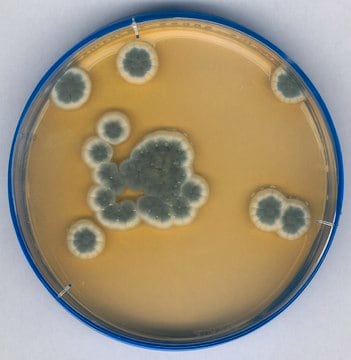N7519
Nutrient broth
Microbiologically tested, NutriSelect® Basic
Iniciar sesiónpara Ver la Fijación de precios por contrato y de la organización
About This Item
Código UNSPSC:
41171607
NACRES:
NA.74
Productos recomendados
Nivel de calidad
esterilidad
non-sterile
Formulario
powder
composición
Beef extract, 3.0 g/L
Peptone, 5.00 g/L
fabricante / nombre comercial
NutriSelect® Basic
técnicas
microbiological culture: suitable
aplicaciones
bioburden testing
environmental
food and beverages
life science and biopharma
water monitoring
idoneidad
bacteria
Categorías relacionadas
Aplicación
Nutrient broth has been used:
- for culturing Azospirillum brasilense
- for reconstitution of freeze dried Staphylococcus aureus culture
- for culturing Pseudomonas aeruginosa NCIMB 8626
Variante de la fórmula
With beef extract and peptone.
Nota de preparación
Solve 8 g in 1 litre distilled water. Autoclave 15 minutes at 121°C.
Nota al pie de página
We offer two media types: the superior granulated GranuCult® and the cost-efficient powdered NutriSelect® culture media, depending on your needs.
The designations basic, plus, or prime are added to indicate the quality control level, from basic quality control to standard QC plus to prime for full regulatory compliance.
The designations basic, plus, or prime are added to indicate the quality control level, from basic quality control to standard QC plus to prime for full regulatory compliance.
Información legal
GRANUCULT is a registered trademark of Merck KGaA, Darmstadt, Germany
NutriSelect is a registered trademark of Merck KGaA, Darmstadt, Germany
Código de clase de almacenamiento
11 - Combustible Solids
Clase de riesgo para el agua (WGK)
WGK 3
Punto de inflamabilidad (°F)
Not applicable
Punto de inflamabilidad (°C)
Not applicable
Elija entre una de las versiones más recientes:
Certificados de análisis (COA)
Lot/Batch Number
¿No ve la versión correcta?
Si necesita una versión concreta, puede buscar un certificado específico por el número de lote.
¿Ya tiene este producto?
Encuentre la documentación para los productos que ha comprado recientemente en la Biblioteca de documentos.
Los clientes también vieron
Incorporation and controlled release of a hydrophilic antibiotic using poly (lactide-co-glycolide)-based electrospun nanofibrous scaffolds
Kim K, et al.
Journal of Controlled Release : Official Journal of the Controlled Release Society, 98(1), 47-56 (2004)
Saikat Jana et al.
NPJ biofilms and microbiomes, 6(1), 19-19 (2020-04-15)
Bacterial biofilms in natural and artificial environments perform a wide array of beneficial or detrimental functions and exhibit resistance to physical as well as chemical perturbations. In dynamic environments, where periodic or aperiodic flows over surfaces are involved, biofilms can
Michele E Barbour et al.
International journal of nanomedicine, 8, 3507-3519 (2013-10-05)
Chlorhexidine (CHX) is an antimicrobial agent that is efficacious against gram-negative and -positive bacteria and yeasts. Its mechanism of action is based on cell membrane disruption and, as such, it does not promote the development of bacterial resistance, which is
Activity of acetyl-CoA carboxylase is not directly linked to accumulation of lipids when Chlorella vulgaris is co-immobilised with Azospirillum brasilense in alginate under autotrophic and heterotrophic conditions
Leyva LA, et al.
Annals of Microbiology, 65(1), 339-349 (2015)
Oskar A Palacios et al.
Microbial ecology, 77(4), 980-992 (2018-11-07)
The effect of three different nutritional conditions during the initial 12 h of interaction between the microalgae Chlorella sorokiniana UTEX 2714 and the plant growth-promoting bacterium Azospirillum brasilense Cd on formation of synthetic mutualism was assessed by changes in population growth
Nuestro equipo de científicos tiene experiencia en todas las áreas de investigación: Ciencias de la vida, Ciencia de los materiales, Síntesis química, Cromatografía, Analítica y muchas otras.
Póngase en contacto con el Servicio técnico












